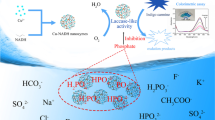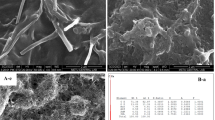Abstract
A tyrosinase-based biosensor was constructed by immobilizing the enzyme on diazonium-functionalized screen-printed gold electrodes. Under optimized conditions, the biosensor exhibited rapid response to the changes in the concentration of all the tested phenolic compounds (catechol, catechin, caffeic acid and gallic acid). Sensitivity, linear range and limit of detection (LOD) were determined, and catechol was found to display the highest sensitivity (36.3 mA M−1) and the lowest LOD (0.1 μmol L−1). The biosensor was successfully applied to the detection of polyphenols in tea samples.




Similar content being viewed by others
References
Valdés M, Valdés González A, García Calzón J, Díaz-García M (2009) Analytical nanotechnology for food analysis. Microchim Acta 166:1–19
Pratt DE (1992) Natural antioxidants from plant material. In phenolic compounds in food and their effects on health II. American Chemical Society, Washington, DC
Rice-Evans CA, Packer L (1989) Flavonoids in health and disease. CRC, Boca Raton, USA
Lu Y, Yeap Foo L (2000) Antioxidant and radical scavenging activities of polyphenols from apple pomace. Food Chem 68:81–85
Sánchez-Moreno C, Larrauri JA, Saura-Calixto F (1999) Free radical scavenging capacity and inhibition of lipid oxidation of wines, grape juices and related polyphenolic constituents. Food Res Int 32:407–412
Blasco AJ, Rogerio MC, González MC, Escarpa A (2005) “Electrochemical Index” as a screening method to determine “total polyphenolics” in foods: A proposal. Anal Chim Acta 539:237–244
Escarpa A, González MC (2001) Approach to the content of total extractable phenolic compounds from different food samples by comparison of chromatographic and spectrophotometric methods. Anal Chim Acta 427:119–127
Cui H, He C, Zhao G (1999) Determination of polyphenols by high-performance liquid chromatography with inhibited chemiluminescence detection. J Chromatogr A 855:171–179
Ishii K, Furuta T, Kasuya Y (2001) Determination of rutin in human plasma by high-performance liquid chromatography utilizing solid-phase extraction and ultraviolet detection. J Chromatogr B 759:161–168
Ishii K, Furuta T, Kasuya Y (2003) High-performance liquid chromatographic determination of quercetin in human plasma and urine utilizing solid-phase extraction and ultraviolet detection. J Chromatogr B 794:49–56
Polásek M, Petriska I, Pospísilová M, Jahodár L (2006) Use of molybdate as novel complex-forming selector in the analysis of polyhydric phenols by capillary zone electrophoresis. Talanta 69:192–198
Xu X, Ye H, Wang W, Yu L, Chen G (2006) Determination of flavonoids in Houttuynia cordata Thunb. and Saururus chinensis (Lour.) Bail. by capillary electrophoresis with electrochemical detection. Talanta 68:759–764
Song Z, Hou S (2002) Sensitive determination of sub-nanogram amounts of rutin by its inhibition on chemiluminescence with immobilized reagents. Talanta 57:59–67
Turner APF, Karube I, Wilson GS (1990) Biosensors: fundamentals and applications. Oxford University Press, USA
Montereali MR, Vastarella W, Della Seta L, Pilloton R (2005) Tyrosinase biosensor based on modified screen printed electrodes: measurements of total phenol content. Int J Environ An Ch 85:795–806
Romani A, Minunni M, Mulinacci N, Pinelli P, Vincieri FF, Del Carlo M, Mascini M (2000) Comparison among differential pulse voltammetry, amperometric biosensor, and HPLC/DAD analysis for polyphenol determination. J Agric Food Chem 48:1197–1203
Abhijith K, Sujith Kumar P, Kumar M, Thakur M (2007) Immobilised tyrosinase-based biosensor for the detection of tea polyphenols. Anal Bioanal Chem 389:2227–2234
Chen J, Jin Y (2010) Sensitive phenol determination based on co-modifying tyrosinase and palygorskite on glassy carbon electrode. Microchim Acta 169:249–254
Franzoi AC, Dupont J, Spinelli A, Vieira IC (2009) Biosensor based on laccase and an ionic liquid for determination of rosmarinic acid in plant extracts. Talanta 77:1322–1327
Gamella M, Campuzano S, Reviejo AJ, Pingarron JM (2006) Electrochemical estimation of the polyphenol index in wines using a laccase biosensor. J Agric Food Chem 54:7960–7967
Gomes SASS, Nogueira JMF, Rebelo MJF (2004) An amperometric biosensor for polyphenolic compounds in red wine. Biosens Bioelectron 20:1211–1216
S-i I, Kong Y-T, Watanabe M (2001) Amperometric biosensor for polyphenol based on horseradish peroxidase immobilized on gold electrodes. Electroanalysis 13:408–412
Mello LD, Alves AA, Macedo DV, Kubota LT (2005) Peroxidase-based biosensor as a tool for a fast evaluation of antioxidant capacity of tea. Food Chem 92:515–519
Kong Y-T, S-i I, Kano K, Ikeda T, Kakiuchi T (2001) Peroxidase-based amperometric sensor for the determination of total phenols using two-stage peroxidase reactions. Am J Enol Vitic 52:381–385
Carralero Sanz V, Mena ML, González-Cortés A, Yáñez-Sedeño P, Pingarrón JM (2005) Development of a tyrosinase biosensor based on gold nanoparticles-modified glassy carbon electrodes: Application to the measurement of a bioelectrochemical polyphenols index in wines. Anal Chim Acta 528:1–8
Eggins BR, Hickey C, Toft SA, Zhou DM (1997) Determination of flavanols in beers with tissue biosensors. Anal Chim Acta 347:281–288
Gooding JJ (2008) Advances in interfacial design for electrochemical biosensors and sensors: aryl diazonium salts for modifying carbon and metal electrodes. Electroanalysis 20:573–582
Griveau S, Mercier D, Vautrin-Ul C, Chaussé A (2007) Electrochemical grafting by reduction of 4-aminoethylbenzenediazonium salt: Application to the immobilization of (bio)molecules. Electrochem Commun 9:2768–2773
Bourdillon C, Delamar M, Demaille C, Hitmi R, Moiroux J, Pinson J (1992) Immobilization of glucose oxidase on a carbon surface derivatized by electrochemical reduction of diazonium salts. J Electroanal Chem 336:113–123
Radi A-E, Muñoz-Berbel X, Cortina-Puig M, Marty J-L (2009) An electrochemical immunosensor for ochratoxin A based on immobilization of antibodies on diazonium-functionalized gold electrode. Electrochim Acta 54:2180–2184
Radi A-E, Muñoz-Berbel X, Cortina-Puig M, Marty J-L (2009) Novel protocol for covalent immobilization of horseradish peroxidase on gold electrode surface. Electroanalysis 21:696–700
Radi A-E, Muñoz-Berbel X, Cortina-Puig M, Marty J-L (2009) A third-generation hydrogen peroxide biosensor based on horseradish peroxidase covalently immobilized on electrografted organic film on screen-printed carbon electrode. Electroanalysis 21:1624–1629
Yang X, Hall SB, Burrell AK, Officer DL (2001) A pH-responsive hydroquinone-functionalised glassy carbon electrode. Chem Commun 2628–2629
Vaik K, Mäeorg U, Maschion FC, Maia G, Schiffrin DJ, Tammeveski K (2005) Electrocatalytic oxygen reduction on glassy carbon grafted with anthraquinone by anodic oxidation of a carboxylate substituent. Electrochim Acta 50:5126–5131
Sarapuu A, Vaik K, Schiffrin DJ, Tammeveski K (2003) Electrochemical reduction of oxygen on anthraquinone-modified glassy carbon electrodes in alkaline solution. J Electroanal Chem 541:23–29
Nassef HM, Radi A-E, O’Sullivan CK (2006) Electrocatalytic sensing of NADH on a glassy carbon electrode modified with electrografted o-aminophenol film. Electrochem Commun 8:1719–1725
Zhou Y, Zhi J (2006) Development of an amperometric biosensor based on covalent immobilization of tyrosinase on a boron-doped diamond electrode. Electrochem Commun 8:1811–1816
Pinson J, Podvorica F (2005) Attachment of organic layers to conductive or semiconductive surfaces by reduction of diazonium salts. Chem Soc Rev 34:429–439
Harrar JE, Shain I (1966) Electrode potential gradients and cell design in controlled potential electrolysis experiments. Anal Chem 38:1148–1158
Laviron E (1979) The use of linear potential sweep voltammetry and of a.c. voltammetry for the study of the surface electrochemical reaction of strongly adsorbed systems and of redox modified electrodes. J Electroanal Chem 100:263–270
Liu Y-C, McCreery RL (1995) Reactions of organic monolayers on carbon surfaces observed with unenhanced raman spectroscopy. J Am Chem Soc 117:11254–11259
Zhang X, van Leeuwen J, Wichers HJ, Flurkey WH (1999) Characterization of tyrosinase from the cap flesh of portabella mushrooms. J Agric Food Chem 47:374–378
Seo S-Y, Sharma VK, Sharma N (2003) Mushroom tyrosinase: recent prospects. J Agric Food Chem 51:2837–2853
Ibarra-Escutia P, Gómez JJ, Calas-Blanchard C, Marty JL, Ramírez-Silva MT (2010) Amperometric biosensor based on a high resolution photopolymer deposited onto a screen-printed electrode for phenolic compounds monitoring in tea infusions. Talanta 81:1636–1642
Acknowledgments
The authors greatly acknowledge the European Commission for financial support through the project “Nutra-Snacks” (FOOD-CT-2005-023044).
Author information
Authors and Affiliations
Corresponding author
Rights and permissions
About this article
Cite this article
Cortina-Puig, M., Muñoz-Berbel, X., Calas-Blanchard, C. et al. Diazonium-functionalized tyrosinase-based biosensor for the detection of tea polyphenols. Microchim Acta 171, 187–193 (2010). https://doi.org/10.1007/s00604-010-0425-y
Received:
Accepted:
Published:
Issue Date:
DOI: https://doi.org/10.1007/s00604-010-0425-y




